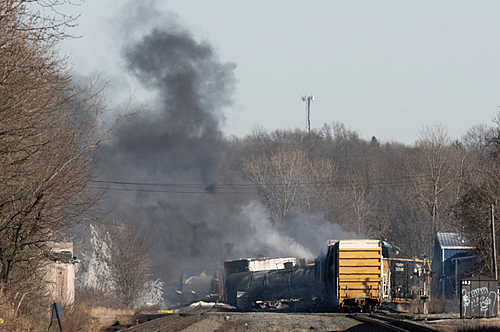
Headaches and the lingering odor caused by chemical compounds from a train derailment in East Palestine, Ohio, have residents worried about the region’s air and water — and misinformation on social media hasn’t helped.
During a press conference on February 14, government officials released more details of the cleanup process, as well as a timeline of the environmental disaster. Approximately ten train cars carrying chemical cargo, including vinyl chloride – a carcinogen – derailed on the afternoon of February 3rd. After the incident, a fire at the site generated dark and acidic smoke. Authorities said they had tested more than 400 homes around the area of the derailment for signs of contamination and were monitoring a cloud of chemicals that leaked and killed 3,500 fish in streams and reached the Ohio River.
However, the slow release of information following the derailment raised many unanswered questions about the risks and long-term impact. O The Conversation posed five questions about chemical payload release to Andrew Whelton, an environmental engineer who investigates chemical hazards in disasters.
Let’s start by talking about what the wagons carried. What are the chemical compounds of greatest concern for human health and the environment in the long term, and what is known so far about the impact of their release?
The biggest concerns now are the contamination of homes, soil and water, mainly by volatile organic compounds and semi-volatile organic compounds, known by the acronym VOCs and VOCs, respectively.
The train had approximately ten carriages with vinyl chloride and other materials, such as ethylhexyl acrylate and butyl acrylate. These chemicals have varying levels of toxicity and different fates in soil and groundwater. Authorities detected some of them near waterways, as well as particulate matter in the air resulting from the fire. A variety of other materials have also been released, but debate over these other compounds has been limited.
Government officials said a cloud of contamination released around a creek reached the Ohio River.
:Air-stripping devices, like the one used above after a derailment, can help separate chemicals from water / US Environmental Protection Agency
Other cities consume water from this river and were therefore warned about the risk [de contaminação]. The further this cloud follows the course of the river, the less concentrated the compounds will be in the water, thus presenting less risk.
In the long term, the greatest danger is in the area closest to the derailment site. And, again, there is little information about what compounds were found or created from chemical reactions arising from the fire.
It is not yet clear how much [desse material] ended up in culverts, streams or may have settled at the bottom of watercourses.
There was also a lot of particulate matter burned – the dark smoke is a clear indication of this. It is not known with certainty how much of this has become airborne or is on the ground.
How long do these compounds remain in soil and water, and what is the potential lasting risk to humans and wildlife?
The heavier the compound, the slower it typically degrades and the more likely it is to stick to the ground. They can remain for years if ignored.
In 2010, after the rupture of the pipeline that reached the Kalamazoo River, in the US state of Michigan, the US Environmental Protection Agency (EPA, its acronym in English) excavated a tributary river where the oil had deposited. We’ve also seen it in leaks off the coasts of Alaska and Alabama. [estados americanos] that petroleum chemicals can contaminate the soil if nothing is done.
The most lasting impact in Ohio will depend, in part, on how fast and thorough the cleanups are.
If contaminated soils and watercourses are excavated and removed, the long-term impact can be reduced. But the longer these removals take, the farther the contamination will spread. It is in everyone’s interest to clean this up as soon as possible and before it rains in the region.
Barriers in a nearby stream were installed to capture chemicals. Air-stripping devices are being used to remove compounds from waterways. This type of equipment removes volatile compounds from the water, releasing them into the air. This is a common treatment technique and was used after the oil spill that occurred in 2015 in the Yellowstone River, near the city of Glendive, in the US state of Montana.
At the derailment site in Ohio, workers are already removing the contaminated soil, extracting about two meters deep in the area near the railcar fire.
Some of the train cars were intentionally drained and the compost burned to dispose of it. This fire generated a dark, thin smoke. What does this say about the compounds and the long-term dangers?
Incineration is one possibility to dispose of hazardous chemical materials. However, their incomplete destruction creates a series of by-products. Chemical compounds can be destroyed when heated to extremely high temperatures so that they burn completely.
The cloud of black smoke seen on TV resulted from incomplete combustion. A number of other compounds were generated. Until tests are carried out, authorities don’t necessarily know what these materials were or where they went.
We know that ash can pose a health risk, which is why we test the interior of homes after fires in which structures burn. That’s one of the reasons the federal director of health told residents who have private water wells near or along the derailment site to use bottled water until the wells are tested.
The US Environmental Protection Agency has been screening homes near the derailment site due to concerns about indoor air quality. How do these compounds get into homes, and what happens to them indoors?
Houses are not airtight, and sometimes dust and other materials get into them. It can be through an open door or window sill. Sometimes it is the people themselves who bring this material into the house.
To date, the EPA has not reported any evidence of high levels of vinyl chloride or hydrogen chloride in the more than 400 homes tested. But it lacks full transparency. Just because a state agency is testing doesn’t mean it’s testing what it needs to be.
Media outlets reported four or five compounds, but a Norfolk Southern manifest [Railway, empresa ferroviária responsável pelo trem] it also listed various other materials on the tanks that caught fire. All of these materials potentially create hundreds to thousands of VOCs and COSVs.
There has been a lot of public debate about VOCs. I encourage discussion about COSVs and other materials. The whole area should be being tested.
Are state authorities testing everything that should be tested?
People in the affected community have been reporting headaches that may be caused by SVOCs and other materials. They are understandably concerned.
Ohio state and federal government officials need to better communicate what they’ve been doing, why, and what they intend to do. It’s not clear what questions they are trying to answer. For such a severe disaster, little information about testing was shared.
In the absence of transparency, disinformation is filling the voids. From a resident’s point of view, it is difficult to understand the true risk if information is not disclosed.
Editing: Flavia Chacon
Source: www.brasildefato.com.br

